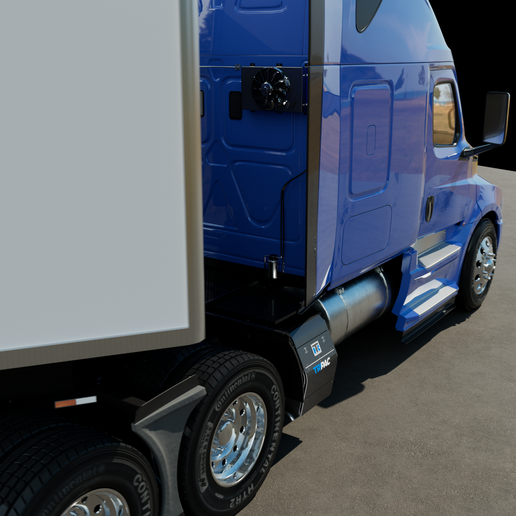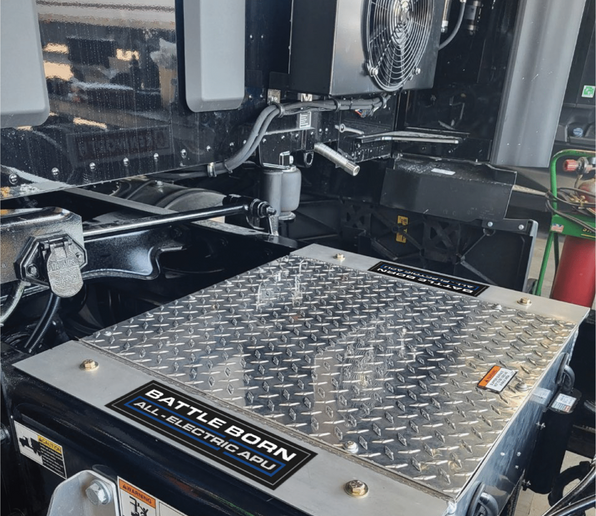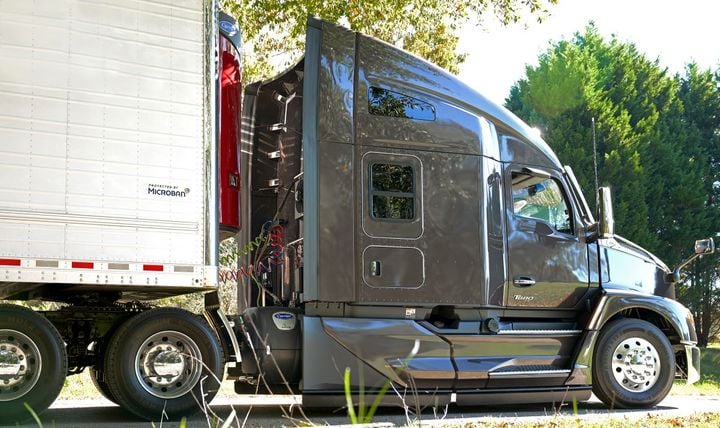Trucker Access › Forums › Diesel News › Beat the Heat: APU Technology Goes Mainstream – Equipment
- This topic has 0 replies, 1 voice, and was last updated 11 months, 1 week ago by
 EazyRiDer66.
EazyRiDer66.
-
AuthorPosts
-
May 10, 2024 at 7:45 pm #19606
 EazyRiDer66Keymaster
EazyRiDer66Keymaster

Volvo designed it’s Parking Cooling APU system to be fully integrated with every aspect of the new VNL tractor’s design.
Photo: Volvo Trucks North America
There’s a long history behind the idling of diesel engines. At the dawn of the diesel age, in the 1930s, fuel was so cheap that it made more sense to just let engines idle for extended periods. The thinking was the engine would burn more fuel restarting than it would at idle.
With the advent of long-haul trucking and — more importantly — in-cab air conditioning, idling became even more commonplace. Truckers routinely ran their engines all night to keep cool in summer and hot in winter.
However, the one-two punch of high fuel prices and ever-stricter emissions and even noise regulations have pretty much ended truck-idling as it existed for decades. Idling not only wastes fuel, the industry realized, but put extra wear and tear on the truck engine.
Today, fleets use various forms of auxiliary power units, or APUs, to power not only the HVAC, but also infotainment systems, refrigerators, and other “hotel loads” inside a cab.
At one time, APUs used small diesel-powered generators. Increasingly, however, they are battery-electric.
APUs and Fuel Savings
The fuel savings APUs can deliver for fleets are substantial.
“The Thermo King TriPac APU consumes approximately 75% less fuel per hour than idling the tractor engine,” explains Charlene Vance, director of product management, APUs, for Thermo King.
“That’s about 2,500 gallons per year in fuel savings, or 10,000 gallons over the typical length of tractor ownership. That’s why APUs are becoming more of a standard solution for fleets that are looking at reducing fuel consumption, increasing driver comfort and reducing tractor engine wear-and-tear.”
Once considered an add-on vehicle system, APUs have moved into the mainstream. And they’re evolving, too.
Power demands have only gone up inside resting trucks. Today, APUs are expected to provide more power for longer periods of time. To do this, they are relying on new technologies and becoming increasingly integrated into vehicle design.
Higher Degrees of Vehicle Integration
APUs have moved beyond fuel and emissions savings to become important driver recruiting and retention enablers.

A diesel-powered APU can save a fleet as much as 2,500 gallons of diesel fuel per year.
With idling forbidden or limited just about everywhere these days, drivers want to sign on with fleets that spec APUs guaranteed to keep them comfortable when they’re at rest.
“While fuel savings are attractive for fleets, driver retention and recruitment are arguably the biggest factors driving APU sales today,” says D.J. Hasler, OEM specialist for Dragonfly Energy, which last year introduced its Battle Born battery-electric APU.
“Think about it: If you’re a driver, and two companies offer the same pay, wouldn’t you choose one where you don’t have to idle the truck all night just to stay comfortable?”
Hasler points out that APUs provide power for heating, cooling, and electronics, eliminating the need to constantly run the engine. This is especially important with the growing demands for devices such as laptop computers, refrigerators, and CPAP machines (to treat sleep apnea) in the cab.
Those are the same reasons Volvo Trucks North America opted to create its own Parking Cooler APU system. Although a factory-installed option of the Parking Cooler has been available since 2016, the latest version was designed from the start to be integrated into the design of Volvo’s new VNL tractor.
“APUs are pretty much standard specs for fleets today,” says Chris Stadler, product marketing manager, Volvo Trucks.
“Particularly with the introduction of our new, 24-volt electrical system on the VNL, we felt like it was the logical course of action to integrate Parking Cooler into the overall design of the truck.”
By doing so, Stadler says, Volvo engineers were able to optimize both the location of the Parking Cooler unit itself, as well as ducting throughout the interior of the VNL cab. The result, Stadler says, is highly efficient heating and cooling throughout the cab.
All of this, Stadler says, is directed at keeping drivers safe, comfortable and productive both on and off duty.
“We use four AGM, deep-cycle batteries to power Parking Cooler,” he says. “This arrangement will keep a driver comfortable at 74 degrees for up to 10 hours — even in the hottest parts of the country during the hottest times of the year.”
Electric APUs and Driver Comfort
Early versions of battery-electric APUs drew complaints from drivers that they didn’t last long enough to cool the cabs overnight, especially in hot climates. APU makers took that into account when designing the latest generation.

More than fuel savings and emissions reductions, driver retention and recruiting are the key drivers behind APU fleet specs today.
Long-term driver comfort and guaranteed starts when it’s time to drive are a top priority for Carrier Transicold’s ComfortPro electric APU, says Bill Maddox, product management at Carrier Transicold.
The system cools truck cabs and sleepers using energy supplied by four Group 31 AGM batteries, which helps preserve the life of the truck battery, according to Maddox.
The under-bunk air-conditioning unit provides 7,500 BTU/hr for up to 11 hours, depending on ambient temperatures, power consumption, solar loading, and cab insulation.
“A variable-speed, fully sealed hermetic electric compressor combined with an efficient power management technology helps maximize run times,” Maddox explains.
“One example of this power-management technology is the cabin pre-cool lock, which assures the preferred cabin temperature is attained before the APU takes over.”
Carrier also offers a version of the ComfortPro powered by lithium batteries.
Lithium Batteries for Improved APU Performance
The introduction of all-electric APUs powered by lithium batteries has been a game-changer for trucks and driver comfort, says Dragonfly’s Hasler. He says these new units offer seamless integration with various air conditioning options, resulting in significantly improved performance.
“Our Battle Born all-electric APU is a great example of this technology,” Hasler says. “It is built specifically for the demands of heavy-duty trucks. Its state-of-the-art lithium battery system is designed for extended life and reliable power that delivers driver comfort with consistent climate control, reliable power, and no auto start/stops.”
Solar panels also are gaining traction in the trucking industry, Hasler adds.
“And there are good reasons for that,” he says. “Many fleets are seeing positive results with solar power.
“However, it’s important to view solar as a complementary solution, not a complete fix. The primary power limitation for APUs remains the battery system, and AGMs fall far short.”
Smarter and More Capable APUs
Another gamer-changer for electric APUs has been the advent of “smart” control systems.
These systems — increasingly powered by artificial intelligence — take on the tricky task of rationing and allocating power as needed. This allows them to wring every usable volt of power from truck batteries while still guaranteeing reliable starting once it’s time to climb behind the steering wheel and get back to work.
According to Stadler, that’s why Volvo engineers opted to fully integrate Parking Cooler into the new VNL’s electronic architecture. Thanks to this approach, the truck’s onboard energy management system will automatically start the truck if it senses the batteries are getting dangerously low.
“This way we can keep drivers comfortable and avoid aggravating service calls and downtime due to dead batteries,” he says.
“APUs are becoming increasingly intelligent,” Hasler says. Many of them can now use CAN communication to integrate seamlessly with the truck’s systems.
“This allows for a single controller to manage both heating and air conditioning, unlike older models with separate controls for each function and an inverter,” he says.
“While not as advanced as the multiplexing screens found in RVs, these integrated systems, especially OEM versions, offer improved functionality.”
One method that allows for smarter power management, Hasler adds, is “load shedding.” When battery levels drop, these systems prioritize essential functions and shut down non-critical ones to prevent a complete power outage.
“This eliminates the risk of drivers being left stranded without power due to a failed automatic start,” he notes.
Shore power is becoming an increasingly popular feature for diesel-powered APUs, as well, says Carrier’s Maddox.
“Shore power provides electric-powered HVAC at any electrified truck stop without the noise and emissions of a diesel engine, leading to better-quality rest and sleep,” he says. “With an optional shore power adapter, Aspen APUs can be operated using 115V shore power when the truck is parked, eliminating the need to run the APU engine for added fuel savings.”
APUs and Telematics
Like any system on a modern truck, telematics and data are becoming increasingly important for APUs as well, Vance adds.

Shore power is becoming increasingly popular for diesel APUs like the Carrier Transicold Aspen.
Photo: Carrier Transicold
“Data is becoming more and more like currency for fleets,” she says. “That’s because it is so valuable when it comes to optimizing both vehicle and fleet operations.”
To meet this need, Vance says the Third Generation TriPac APU comes standard with 24 months of complimentary TracKing telematics to provide line of sight to APU run hours and cabin temperatures, as well as automate fuel tax reporting.
APUs are clearly mainstays for long-haul fleets now. And their importance – and capabilities — are expanding accordingly. If today’s trends are any indication, smarter, stronger and more powerful and more flexible. Just like the industry and the vehicles they serve.
-
AuthorPosts
- You must be logged in to reply to this topic.